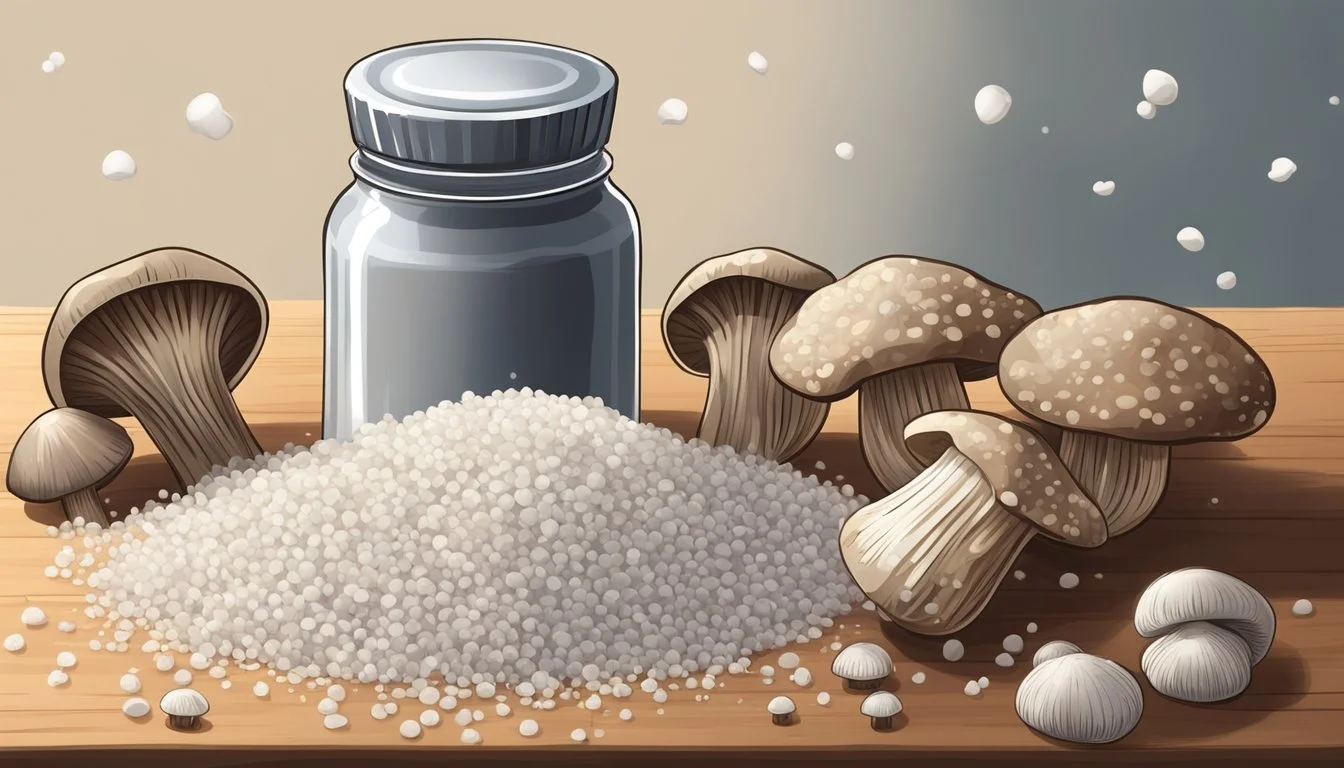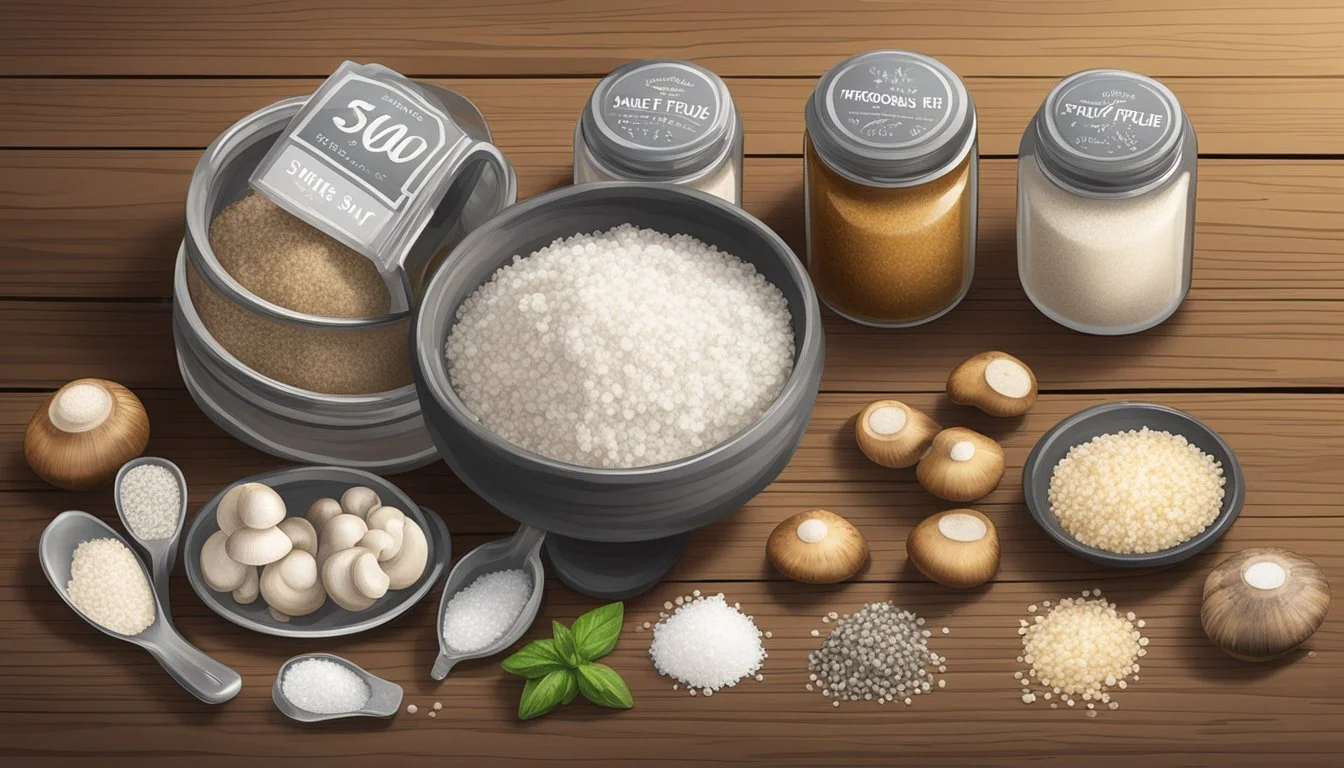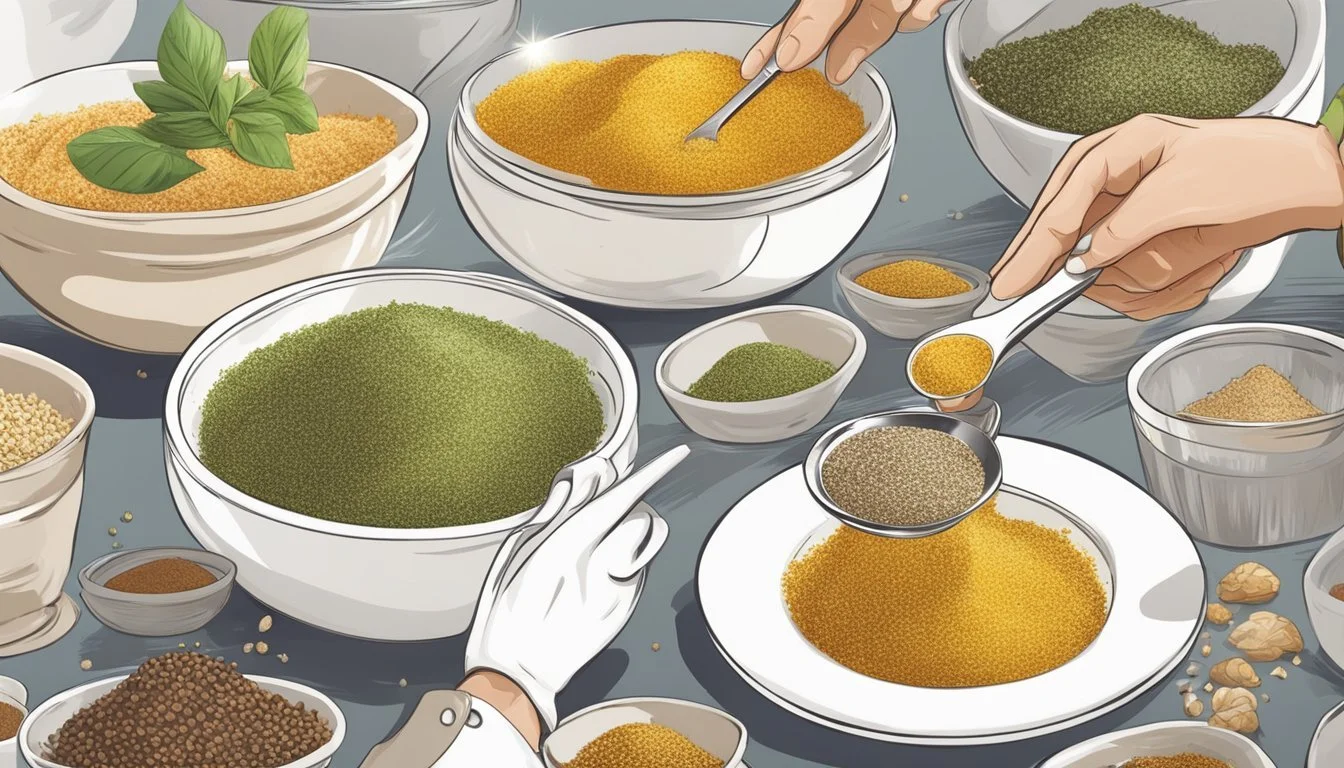Truffle Salt Substitutes
Top Alternatives for Gourmet Flavor
Truffle salt is a cherished ingredient among culinary enthusiasts, prized for its unique and earthy flavor. Yet, it can be quite expensive and sometimes hard to find. For those seeking a cost-effective alternative, truffle oil is an excellent substitute that captures the essence of truffles while being more readily available.
Other effective substitutes include truffle paste and porcini mushroom oil, which offer robust flavors that complement a wide range of dishes. If you’re in search of a more affordable option, garlic oil or extra virgin olive oil can also provide delightful enhancements to your meals.
From truffle cheese, which provides a unique twist, to Worcestershire sauce in a pinch, these alternatives make it easy to elevate your culinary creations without breaking the bank. The variety of substitutes ensures that you won't have to compromise on flavor, even when truffle salt is out of reach.
Understanding Truffle Salt
Truffle salt combines the richness of truffles with the basic salt seasoning, lending dishes a distinctive umami flavor. It becomes a gourmet staple for chefs and home cooks alike, offering various culinary, nutritional, and economic considerations.
Defining Truffle Salt
Truffle salt is a blend of sea salt and finely ground truffles. It can include black or white truffles, each contributing its unique taste. The truffle's intense, earthy, and aromatic qualities complement the salt, making it a sought-after seasoning. This mix provides a powerful punch of flavor, typically used to finish dishes rather than during cooking.
Culinary Uses of Truffle Salt
Truffle salt elevates simple dishes with its savory umami essence. Common uses include sprinkling on popcorn, pasta, eggs, and risotto. It pairs exceptionally well with steaks and roasted vegetables. Chefs often use it as a finishing salt to enhance the flavors without overpowering the dish. The versatility of truffle salt makes it a valuable addition to any kitchen.
Health Benefits and Nutrition
While truffle salt is primarily appreciated for its flavor, it also offers some nutritional benefits. Truffles contain antioxidants and have anti-inflammatory properties. Furthermore, sea salt variants used in truffle salt can contain trace minerals like magnesium and potassium. However, moderation is key due to the sodium content, which can impact blood pressure.
Explaining the Cost
The high cost of truffle salt is attributed to the expensive nature of truffles themselves. Truffles are rare and require specific growing conditions, making them pricey. Additionally, the harvesting process is labor-intensive. These factors contribute to the premium price of truffle salt. Despite this, it remains a popular choice for those looking to incorporate gourmet flavors into their cooking.
Truffle salt’s combination of rarity, complex flavor, and potential health benefits make it a distinct and desirable seasoning, worth its higher price for many.
Key Ingredients in Truffle Salt
Truffle salt combines high-quality salt with aromatic truffles. This section will explore the specific types of truffles used, the varieties of salt, and any additional flavorings.
Identifying Real Truffles
Truffles are a key component of truffle salt. Both black truffles and white truffles are utilized, each bringing unique flavors.
Black truffles offer a more robust, earthy flavor. They are commonly sourced from countries such as France and Italy.
White truffles tend to have a lighter, garlicky aroma. They are often harvested in regions like Alba, Italy.
Using real truffles, rather than synthetic alternatives, ensures a genuine umami flavor.
Salt Varieties Used
The choice of salt impacts the overall experience of truffle salt. Sea salt is a preferred option due to its texture and purity.
Another popular choice is Kosher salt for its larger grains and ability to stick well to food.
Some producers use Himalayan pink salt, which adds a subtle mineral note.
These salts enhance the salty flavor while complementing the truffles’ earthy and umami qualities.
Aromatics and Flavorings
While truffles and salt are the primary ingredients, some blends incorporate additional aromatics.
Common enhancements include garlic powder and onion powder, which boost the overall profile.
Occasionally, herbs such as thyme or rosemary are added for complexity.
These flavorings work to deepen the truffle salt’s appeal, making it not just salty but richly aromatic.
Substituting Truffle Salt
Finding the perfect substitute for truffle salt involves examining a variety of ingredients, including truffle oil, alternative salts with different mineral content, herb and spice infusions, and homemade seasoning blends.
Truffle Oil and Its Uses
Truffle oil is a popular alternative to truffle salt. Made by infusing oil with truffle essence, it provides the distinct truffle flavor without the salt. Truffle oil can be made from several base oils, including canola oil, olive oil, or grapeseed oil.
To use truffle oil, drizzle it over finished dishes like pastas, steaks, or risottos. It enhances the flavor profile without the need for added salt, making it a suitable choice for those concerned about blood pressure or heart disease.
Alternative Salts and Mineral Content
Sea salt and other specialty salts can serve as good substitutes when looking for a different mineral content. Sea salt provides a nuanced flavor and can often be found with various trace minerals.
For those looking for affordable options, table salt or iodized salt can be used in conjunction with other truffle-flavored ingredients. Using these salts reduces cost while still imparting significant flavor.
Herb and Spice Infusions
Creating herb and spice infusions is an excellent way to mimic the complexities of truffle salt. Combining spices like garlic powder, dried thyme, and black pepper with less expensive salts can yield remarkable results.
These infusions add layers of flavor, and their versatility means they can be adjusted to taste. This method is also beneficial for those wanting to control their sodium intake while still enjoying robust seasoning.
Homemade Seasoning Blends
Homemade seasoning blends offer a custom approach to replacing truffle salt. By mixing common ingredients such as dried mushrooms, garlic powder, and various herbs, you can create a unique blend that matches your culinary needs.
These blends can be tailored to suit specific recipes and personal taste preferences. Additionally, making them at home ensures that you know exactly what is in your seasoning, which is helpful for maintaining dietary considerations such as low-sodium or heart-healthy diets.
Budget-Friendly Options
Truffle salt can be quite expensive, but there are several budget-friendly alternatives that can add similar flavors to your dishes. Affordable options include mushroom-based substitutes, accessible truffle alternatives, and cheese or oil combinations.
Porcini Mushroom Substitutes
Porcini mushrooms are a great alternative to truffle salt. They offer a rich, earthy flavor at a fraction of the cost. Using porcini mushrooms, porcini salt, or porcini mushroom oil can bring a depth of umami to your dishes.
Porcini salt can often be found at specialty grocery stores or made at home by blending dried porcini mushrooms with sea salt.
For an oil-based substitute, porcini mushroom oil can mimic the luxurious taste of truffles, ideal for drizzling over pasta or risotto.
Affordable Truffle Alternatives
Making a homemade truffle salt is another cost-efficient method. Mix high-quality sea salt with a small amount of chopped fresh or dried truffles. This DIY method reduces the need for large quantities of truffles while still delivering bold flavors.
Truffle oil, made from a blend of oils such as olive, canola, or grapeseed oil infused with truffles, can also be a more affordable option. These oils can be used sparingly as finishing oils for various dishes.
Utilization of Cheese and Oils
Parmigiano Reggiano cheese can introduce a complex profile to your meals, similar to what truffle salt provides. Grate finely or shave over dishes to enhance flavor.
Olive oil and grapeseed oil, though not truffle-infused, can be combined with garlic oil or herb-infused oils to boost the overall taste. These oil mixtures work well in sauces, soups, and dressings, delivering richness and depth.
By keeping these budget-friendly options in mind, you can recreate the truffle salt experience without breaking the bank.
DIY Truffle Salt and Oils
Making your own truffle salt and infused oils at home can be both rewarding and cost-effective. This approach allows you to use high-quality base ingredients and ensures that the flavors are authentic and fresh.
Recipes for Homemade Truffle Salt
Creating homemade truffle salt involves combining fresh truffles or quality truffle products with coarse sea salt. For a basic recipe:
Ingredients:
1 ounce of fresh truffles (finely grated)
1 cup coarse sea salt
Instructions:
Finely grate the truffles using a microplane or fine grater.
Mix the grated truffles with the sea salt in a bowl.
Spread the mixture on a baking sheet and let it dry for a few hours in a cool, dry place.
Store in an airtight container.
Tip: For an alternative, use truffle zest or truffle powder if fresh truffles are unavailable. A ratio of 1:10 (truffle product to salt) is usually effective.
Crafting Your Own Infused Oils
Infused oils capture the aromatic and flavor qualities of ingredients such as truffles. Homemade truffle oil can be made using extra virgin olive oil or other neutral oils like grapeseed or hazelnut oil.
Ingredients:
1 cup extra virgin olive oil or other neutral oil
1-2 ounces fresh truffles (cleaned and chopped)
Instructions:
Method 1: Heat the oil gently to about 200°F (93°C).
Add the chopped truffles and continue to heat for about 10 minutes.
Remove from heat and let the mixture cool and infuse for a few hours.
Strain out the truffle pieces and bottle the oil.
Method 2: Place chopped truffles in a bottle.
Pour oil over the truffles.
Seal the bottle and let it infuse in a cool, dark place for about two weeks.
Strain before use.
Recommendation: Use the oil within a couple of months for the best flavor. Refrigeration can extend its shelf life.
By making these at home, individuals can avoid synthetic products and ensure the use of real, seasonal ingredients, enhancing the culinary experience.
Enhancing Dishes without Truffle Salt
Enhancing dishes without truffle salt can be achieved by incorporating various substitutes, creating unique flavor profiles, and using different seasonings and finishing touches. Readers will find solutions for maintaining savory and earthy flavors in their culinary creations.
Substitutes in Cooking and Garnishing
Truffle Oil: A versatile substitute for truffle salt, truffle oil can be used sparingly to finish dishes like pasta, roasted vegetables, fries, and even popcorn. Its earthy flavor adds depth without overwhelming bitterness.
Garlic and Herbs: Ingredients such as garlic, rosemary, and sage can replicate some of the savory notes. These are perfect for seasoning meats like steaks or enhancing scrambled eggs.
Earthy Ingredients: Truffle-infused options like truffle carpaccio offer a robust alternative. Also, products like Worcestershire sauce and balsamic vinegar provide rich flavors suitable for various dishes.
Creating a Unique Flavor Profile
Lemon Juice and Black Pepper: Combining these two can help balance flavors and add subtle complexity. Lemon juice brings brightness, while black pepper offers pungency, ideal for salads or seafood.
Nutritional Yeast and Dill: Nutritional yeast, with its cheesy flavor, paired with dill, introduces a new dimension to dishes such as pasta or roasted vegetables. It’s an excellent choice for vegan or dairy-free diets.
Ginger and Coconut Aminos: These create a sweet and savory blend suitable for stir-fries or marinades. The pairing imparts a unique zest to traditional recipes.
Seasonings and Finishing Touches
Herb Mixes: Blends of spices like coriander, red pepper flakes, and tarragon infuse complex layers into dishes. These mixes can be sprinkled on salads, soups, or roasted dishes.
Apple Cider Vinegar and Cinnamon: Adding these ingredients can introduce tartness and warmth. Perfect for marinading poultry or seasoning roasted squash, they create intriguing flavor profiles.
Versatile Finishes: Utilizing items like nutritional yeast, balsamic vinegar, or Worcestershire sauce as finishing touches brings a bold flair. Especially useful for garnishing, these seasonings elevate the final dish.
Truffle Salt and Health Considerations
When considering truffle salt, it's important to discuss its sodium content, potential allergens, and the quality and origin of the product. These aspects impact both health benefits and possible risks.
Sodium and its Effects
Truffle salt primarily consists of sea salt mixed with pieces of dehydrated truffles. A small serving can contain around 190 milligrams of sodium. High sodium intake is known to elevate blood pressure, increasing the risk of heart disease. Health-conscious individuals should use truffle salt sparingly. When incorporating it into meals, balance its use with other low-sodium ingredients to maintain overall dietary health.
Allergies and Dietary Restrictions
Truffle salt contains truffle, a type of fungus. People with a history of allergies to certain fungi should exercise caution. While rare, some might experience allergic reactions. Also, those on a low-sodium diet or with conditions like hypertension should monitor their intake. It's advisable to consult a healthcare provider for personalized recommendations if any concerns arise.
Quality and Origin of Products
The quality of truffle salt varies significantly with the origin of its ingredients. Premium products often use high-quality truffles and sea salt from reputable sources. Consumers should check labels for information on sourcing and production methods. Authentic truffle products usually provide more nuanced flavors and potential health benefits compared to lower-quality alternatives.





